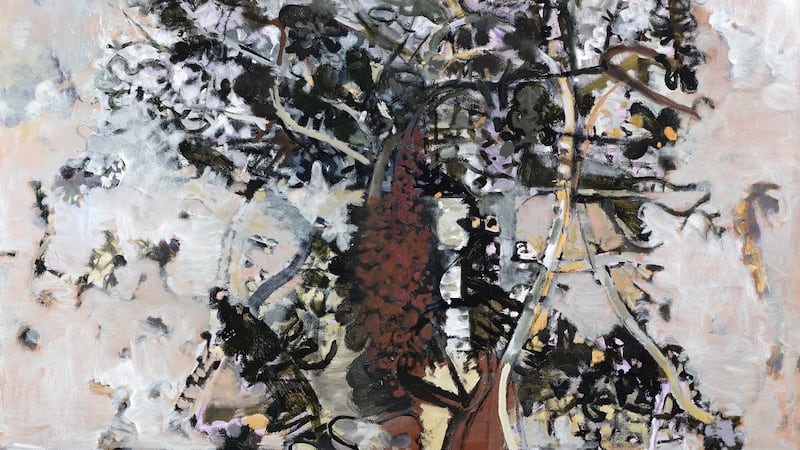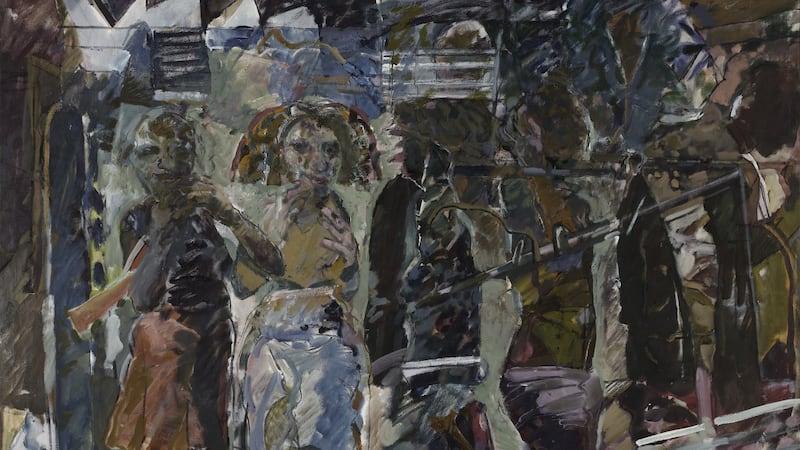Echoes and Reflections
David Crone retrospective. RHA Gallagher Gallery, 15 Ely Place. Until December 21st. rhagallery.ie
*****


Approaching his 80th birthday next year, David Crone is one of the best painters to have emerged on the island of Ireland in the space of his lifetime. You could say, to have emerged in the 20th century, but you’d really have to include the current century, because he’s made a significant proportion of his best work over the past 16 years, none of it rehearsing old ideas, all of it fresh and innovative.
Earlier this year, Crone's contemporary, David Hockney quoted a Chinese saying in relation to himself: "Painting is an old man's art." In truth, individual artists can peak at different stages of their lives, but the nature of painting is that you learn on the job, accumulating skill and insight. And Crone is an exceptionally thoughtful, introspective artist.
Echoes and Reflections, jointly organised by the FE McWilliam Gallery in Banbridge and the RHA in Dublin, is best described as a partial retrospective. An introductory note accurately acknowledges that, substantial as it is, the show "can only hope to scratch the surface of a remarkable body of work". Despite the fact that it is unimaginatively, even monotonously, laid out in the RHA's cavernously difficult main gallery space, the exhibition is a delight and includes many pieces that are breathtakingly good.
Crone was born in the Lisburn Road area of Belfast and attended Annadale Grammar School, where he was fortunate to encounter the exceptionally keen art teachers Wilfred Stewart and Kenneth Jamison. When he went on to Belfast College of Art, he signed up for sculpture. By the time of his graduation, still making sculpture, he had begun to gravitate towards painting via an increasing interest in making "preparatory" drawings and watercolours. He started working as an art teacher at a secondary school, and then at his own old school, Annadale, something of an academic powerhouse in the fine arts of Ulster.
In terms of his own work, it seems fair to describe him as a slow learner in the aftermath of art college; slow but industrious, omnivorously curious and remarkably unself-conscious. It’s hard to think of another painter whose art is so directly rooted in process, in the sense that you can see the formation of his thought as he works. He does not try to arrive at the kind of highly polished finish that might divert attention from the mechanics of what is going on behind the scenes. Consistently throughout his career he has been admirably indifferent to impressing his audience with special effects. As soon as a work is resolved to his satisfaction, he stops. Hence the unfailing sense of liveliness and informality that attends his painting.
In 1975 he moved on from teaching at second level to third level, at the then Ulster Polytechnic, later the University of Ulster. Immediately prior to this move, he was uneasy about his work. Simply put, he was hard to place, aesthetically, in the context of contemporary art, and felt disorientated. He was clearly not an abstract painter, and had no inclination to become one. He found himself in the midst of a city, and a country, increasingly in the throes of the Troubles, but that experience did not politicise and determine the form of his work as it did that of a younger generation.
Yet this moment of crisis, if that doesn’t over-dramatise his predicament too much, prompted a move forward into his maturity as a painter. His work beganto incorporate the reality of the fractured city, because that was the reality of the time. In fact, the fluid, fragmentary, piecemeal nature of experience and setting that his paintings went on to explore evoke not just the Belfast of the Troubles but to a large extent the quality of urban life in general, never more so than now, when we encounter the increasingly complex jumble of physical and virtual, thanks to the advent of smartphones and tablets.
Crone's paintings delight in the ambiguities of screens, shop windows, vivid reflections, abrupt openings and closings, gaps and obstructions, street plans and diversions, demolitions and newbuilds, a labyrinth-cum-hall of mirrors, negotiated from minute to minute by the hapless human subjects who are always present, even if it can be hard to read the exact nature of their presence. Their roles, too, are fluid, depending on circumstance: they too might be reflections, mannequins or, more urgently, perhaps Falling Figure or Victim, Tourist and Model. The simple motif of the shop window at night was crucial in opening up access to these multiple layers of imagery.
While Crone had worked, as teacher and artist, in the heart of Belfast, he’d lived somewhat further out, in Holywood, from 1969. Then, in 1994, he moved again, to Spa, near Ballynahinch; not a huge distance, but a much more rural environment. That marked a significant shift in his work, especially following his retirement from teaching. In terms of imagery, the country replaced the city, but the layering, fragmentation and complexity persisted.
Garden, field and pool take over from the urban iconography, but the qualities of ambiguity, uncertainty and doubt persist, even as Crone is as precise as ever on detail: the outline of a leaf, the shape and colour of a plant, the assembly of a plethora of individual observations.
There are fast painters and slow painters. Crone is somewhere in between, both fast and, probably more so, slow. Picasso, missing the point, once dismissed Bonnard as "a pot-pourri of indecision". One feels that Crone would like Bonnard, a slow painter. And Sickert, to whom he has often and justifiably been compared. Equally, Braque comes to mind. He has certainly looked carefully at Francis Bacon and Philip Guston. Closer to home, Jack B Yeats and Eithne Jordan seem distinctly related. Crone is not – as he is often termed – an expressionist by any conventional definition, being always measured and detached. But if ever there was a painter at home in his own work, it is he.











